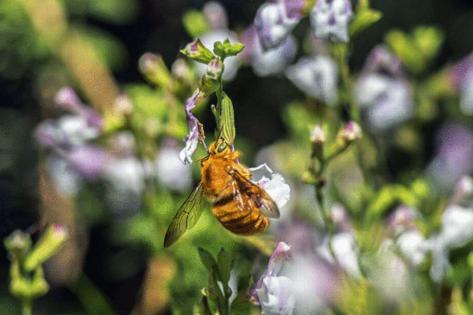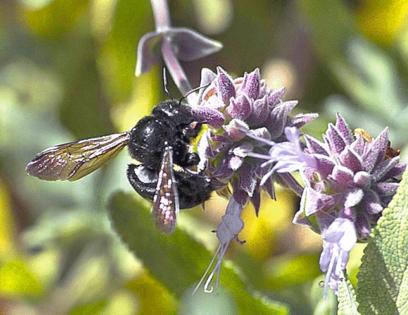Carpenter bees can chew through your California home. How to get rid of them
Published in News & Features
SACRAMENTO, Calif. – Notice giant black bees buzzing around your backyard?
That could spell trouble for your deck or fence, according to David Headrick, Cal Poly professor emeritus of entomology and pest management.
Those enormous insects you’ve spotted are carpenter bees, he said.
Carpenter bees use their powerful jaws to burrow into wood, leaving “siding, sheds, garages, playsets and wooden patio furniture scattered with ugly holes,” according to AAI Pest Control in Modesto.
Are carpenter bees dangerous? Do they sting? And how can you get rid of them?
Here’s what to know:
How can I tell if I have carpenter bees in California?
According to Headrick, three kinds of carpenter bees call California home.
The most common type is Xylocopa varipuncta, also known as the Valley carpenter bee.
They’re found across the western United States as well as Hawaii, Florida and “all of Mexico,” said Headrick, an insect specialist who worked for Cal Poly’s Plant Sciences department for nearly 30 years.
Female Valley carpenter bees are a dark, iridescent blue, while the males are covered with golden brown fur.
These “large and robust insects” may resemble bumblebees but they’re much bigger, according to the University of California’s Statewide Integrated Pest Management Program.
Females range from about 5/8 to 1 inch long, while their male counterpoints are slightly smaller, the program said.
You might also encounter Xylocopa californica, the California carpenter bee, or Xylocopa tabaniformis orpifex, a subspecies that’s sometimes referred to as the foothill carpenter bee, Headrick said.
When do you see carpenter bees?
Carpenter bees are active from early March through October in Northern and Central California, according to Best Bee Brothers, a family-run Wisconsin business that’s “dedicated to helping families take back their homes from the damages of carpenter bees.”
In Southern California, the brawny bees are active from February through October, the company said.
“Carpenter bees thrive in warm weather,” Best Bee Brothers said. “The warmer the climate, the longer the activity period.”
You’re most likely to notice the big insects in the spring and early summer, when they emerge from their overwintering tunnels to find mates, create nests and lay eggs, experts said.
Can carpenter bees damage my home? Deck?
As their name suggests, carpenter bees “cause damage to wooden structures by boring into timbers and siding to construct nests,” according to the Statewide Integrated Pest Management Program.
“The nests weaken structural wood and leave unsightly holes and stains on building surfaces,” the pest management program states on its website.
A female carpenter bee can chew a hole measuring up to three-quarters of an inch in diameter and 10 inches deep, Headrick said, and each hole can lead to a veritable warren of interconnected chambers that bees return to “year after year.”
“Over a period of time, tunnels may extend as far as 10 feet into wood timbers,” the pest management program said.
Carpenter bees prefer “sound, undecayed wood without paint or bark” to make their homes, although they’ll also bore into lumber and dead wood on trees.
Do carpenter bees sting? Are they dangerous?
Carpenter bees are “very territorial,” Headrick said. “They put on a show because they’re such big insects. ... They do buzz you a bit.”
Female Valley carpenter bees will only sting if provoked — “You’d have to be literally touching or confining (the bee) in some way before she’d sting you,” he explained — while male carpenter bees can’t sting at all.
“They’re absolutely harmless,” Headrick said.
Why are carpenter bees important for environment?
As annoying as those wood-chomping carpenter bees might be, the burly, buzzing insects serve an important role in the ecosystem, according to Headrick.
Carpenter bees are “superior pollinators of native species” such as California fuchsia, coyote brush, sticky monkey flower and ceanothus, also known as California lilac, he explained.
The big bees are even adept at pollinating plants with tiny flowers, Headrick said.
They use wing vibrations to jostle loose pollen — a process called “sonic pollination” — before collecting the fine, fertile powder.
According to Headrick, carpenter bees also pollinate nonnative species such as blueberries, melons, tomatoes, eggplant and squash.
How can I get rid of carpenter bees without killing them?
Although pest control companies offer lethal solutions such as carpenter bee traps or chemical treatments, the best way to keep carpenter bees from bugging you is using stained, sealed, varnished or otherwise treated wood in building projects, Headrick said.
You can cover exposed wood such as the ends of timbers with wire mesh or metal flashing, the Statewide Integrated Pest Management Program said, and “fill depressions and cracks in wood surfaces so they are less attractive” to pests.
Carpenter bees prefer softwoods such as California redwood, cedar, pine and Douglas fir, experts said, so you’re better off using hardwoods or artificial wood materials when building.
If you spot a carpenter bee gnawing with its massive mandibles, don’t panic.
Simply wait until the bee has left its tunnel, Headrick said, then use Liquid Nails or a similar adhesive to plug the hole.
“Prevention is the main approach to managing carpenter bees,” the pest management program said.
____
©2025 The Sacramento Bee. Visit at sacbee.com. Distributed by Tribune Content Agency, LLC.










Comments